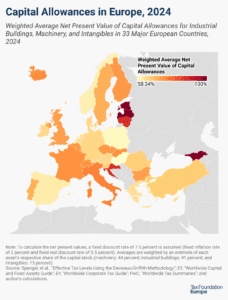
Fiscal Forum: Future of the EU Tax Mix with Dr. Stefanie Geringer
14 min readBy:In August 2024, I had the opportunity to interview Dr. Stefanie Geringer, a postdoctoral researcher at the Faculty of Law at the University of Vienna and Masaryk University Brno, a certified taxA tax is a mandatory payment or charge collected by local, state, and national governments from individuals or businesses to cover the costs of general government services, goods, and activities. advisor and manager of tax at BDO Austria, about the future of the EU tax mix. A lightly edited transcript from that interview follows and shows that Member States may have very different perceptions of the “optimal” tax mix, that certain taxes have increasing potential in the crisis-driven realities of the 21st century, and that there is considerable room for improvement of the EU’s VAT at both the supranational and national level.
Sean Bray: How would you characterize the current EU tax mix?
Stefanie Geringer: The first thing that popped up in my mind when I thought about this question was the EU’s slogan, “United in Diversity.” I think this is how the tax mix in the EU can be best described. Of course, one can see these general trends that we also have in national contexts outside the EU. Social security contributions, the personal and corporate income taxA corporate income tax (CIT) is levied by federal and state governments on business profits. Many companies are not subject to the CIT because they are taxed as pass-through businesses, with income reportable under the individual income tax. , and the value-added tax make up most of the revenues. However, already among these taxes, we can see some significant differences between the Member States, in regard to their role and relevance.
When we think about the tax-to-GDP ratio, there are some Member States that impose higher taxes overall because they employ a more developed system of redistribution, and other Member States that have a different view on the matter. We can also see that Member States may have different approaches to the “ideal” use of these taxes. Czechia, for example, relies heavily on social security contributions, while applying rather low personal income tax rates, which can generally be 15 or 23 percent. Compare this to Austria, where the personal income tax rate can be up to 55 percent. Other Member States do not have this focus on the personal income tax or social security contributions. This is particularly true for Croatia and Hungary, which can be explained, at least to some extent, by the fact that they have relatively high VAT rates.
Apart from that, we can also see differences in the use of health or environmental taxes as part of related national policies. Environmental taxes have become particularly important in the Nordic countries, while their introduction may be a rather big discussion issue in what has been labelled the “new Member States.” Some countries have general wealth taxes, for example, Spain, whereas in Austria there is “only” a recurrent real estate taxAn estate tax is imposed on the net value of an individual’s taxable estate, after any exclusions or credits, at the time of death. The tax is paid by the estate itself before assets are distributed to heirs. .
So, even though we often speak of the EU in terms of increasing harmonization, we don’t see so much of this in the tax context. EU countries are indeed rather eager to keep their remaining tax sovereignty.
This is even true for the value-added tax, which is my area of expertise. VAT is broadly harmonized in the EU. Still, Member States can decide which role the VAT plays in the national tax mix—not only because they can set the tax rates, but also because they can individually determine the threshold for SMEs; that is, whether and which small and medium businesses should be exempt from VAT. Member States can also introduce VAT grouping, and thereby influence the extent to which there are taxable supplies between related companies. There’s still a lot that can be decided at Member State level.
Sean Bray: What do you think should happen in the EU over the medium term to make the EU fiscal space more stable and democratically legitimate?
Stefanie Geringer: I’ll start at the national level. EU Member States and other countries that we might refer to as developed countries all face similar challenges, such as digitalization, globalization, and an aging population. For many years, the focus of tax policy has been on base erosion and profit shiftingProfit shifting is when multinational companies reduce their tax burden by moving the location of their profits from high-tax countries to low-tax jurisdictions and tax havens. , which I also dealt with in my doctoral thesis. Previously, the debate was focused on corporations. The discussion has since somewhat moved on. We see the phenomenon with digital nomads that can work from anywhere, with the COVID-19 pandemic having accelerated this effect. In the EU, there are Member States, such as Portugal or Italy, that encourage these people to move to their countries using beneficial tax schemes. In my opinion, there should be a broader discussion on tax strategies concerning individuals.
In the face of increasing competition in the income tax arena, it is important to assess the potential of other taxes to meaningfully contribute to the financing of state expenditure. I was very happy to see that the Tax Foundation website also referred to recurrent real estate taxes in this context. They will be the focus at the upcoming Annual Congress of the European Association of Tax Law Professors (EATLP) in Bergen, Norway, and rightly so. I think these taxes have great potential, particularly in light of the often-cited mobility of capital and, to some extent, people. In contrast to them, real estate is necessarily intangible. Economists have stressed their potential for years, but it remains to be seen whether the legislator will follow suit. Increasing taxes on housing is a very sensitive issue. Concerns about the affordability of homes can easily be instrumentalized in political discussions.
I also think that over the next couple of years environmental taxes will become even more important. I see lots of potential for taxes encouraging an efficient use of resources, such as water. Discussions have already gone further in this direction in Australia, for example, while I assume that they will increasingly be debated also in Europe. What I hope will not make a revival are general wealth taxes because I do not consider them to be efficient.
When contemplating about how to ensure that there will be sufficient tax revenue in the future, one should not only think about the revenue side, but also the expenditure side. We should not only be concerned about the erosion of tax bases but also ask whether the money collected is spent in a meaningful way.
Related to this is the question of democratic legitimacy. I’m very happy that there is an increasing interest in researching this topic. It’s essentially about the extent to which people may influence taxation and spending through their voting decisions. Eventually, it might be worthwhile trying to find a more immediate way for taxpayers to influence decisions. There are some real-life examples of countries where taxpayers may decide when filing their tax returns how [parts of] the money should be spent. I assert that such systems, even if they are used to a limited degree, might encourage taxpayers to comply with tax laws and pay taxes because they will then be better able to estimate the impact.
Regarding the EU level, I am unsure whether there is currently a legal basis for introducing genuine EU taxes, which I understand in the sense that the EU would have the full legislative and revenue authority to them. Beyond limitations to the EU’s competences, I’m pretty sure that there’s also no unanimous political will to introduce genuine EU taxes among Member State politicians for the time being. I’m also a bit skeptical about whether this would actually be desirable. There is a broader discussion in tax scholarship whether we should introduce genuine EU taxes, but it is far less explored whether it actually makes sense to bring taxation to the EU level. The key question we should ask ourselves in this context is: What could be gained from this?
Sean Bray: What role does VAT generally play in the broader tax mix, and what are the economic trade-offs?
Stefanie Geringer: To begin with, we can observe that, to some extent, there is a shift of the tax burden from income taxes towards consumption taxes. My guess is that, in the future, consumption taxes will become even more important. Regarding the VAT, this is for several reasons in particular.
Taxes on income may influence people’s decision-making when considering where to establish their businesses and whether to move abroad. An ideal VAT, on the other hand, should provide for full deduction of input tax for businesses, so that the VAT would be a transitory item for them and a neutral factor in business planning. VAT is easier to administer and, as we’ve seen during times of crisis, a very reliable revenue raiser. When we had shortfalls on personal income taxes, social security contributions, and smaller taxes related to wages during the COVID-19 pandemic, VAT still brought in significant revenue because people maintained a certain level of consumption. I would say the biggest, and well-known, challenge under a value-added tax is its potential regressivity, rendering it particularly burdensome for lower income households. Whether a VAT can effectively be regarded as regressive depends on whether we put the VAT burden in relation to income or consumption (and over which period), and whether we focus on consumption in absolute or relative terms.
In any case, there are different approaches to addressing the potential regressivity of the VAT. In-system measures such as exemptions and reduced tax rates have a long tradition but have proved comparatively inefficient. It is generally considered favorable to apply a broad-based VAT and to solve the regressivity issue primarily through cash transfers and government services. This approach has been applied most rigorously in New Zealand. However, it comes with its own set of challenges. Recent research, including my own, has begun to explore the prospects of technology-based solutions. Some discuss models for real-time compensation of the VAT burden, while others develop possibilities for applying progressive VAT rates. If appropriately designed, such approaches would provide relief at the time of the supply, so they would eliminate cashflow disadvantages. What I consider as one of the main issues of technology-based solutions is data protection, thus preventing that taxpayers become increasingly transparent. There are also further, socio-legal implications related to this topic, which I will further explore as part of a newly developed strand of research of mine. Overall, I assert that this area has a lot of potential for future research.
Sean Bray: Should the EU’s VAT be reformed, and if so, what should policymakers focus on? Are there political constraints to consider?
Stefanie Geringer: To appropriately address these questions, I might first have to ask how much time we’ve got left? Joking, of course. Quite fundamentally, it makes sense to distinguish between the national and the EU level. As already mentioned, there is a certain degree of discretion for Member States under the EU VAT Directive, and I would argue that many of the current VAT issues in the Member States are actually “homemade.”
This concerns, first and foremost, VAT rate differentiations. Different from exemptions, Member States are not obliged under EU law to apply reduced rates. Denmark is the only Member State applying a single-rate system. The others apply at least two rates or more. The issues permeating rate differentiations are well researched. Notwithstanding this, the general tendency seems to be towards even further rate differentiation, especially since a reform of the EU legal framework in 2022, that allows Member States to apply up to five different VAT rates. This has led to substantial political pressure to make use of the new room for maneuver. However, for completeness’ sake, it should also be mentioned that some Member States have applied a different rate policy. In Czechia, for example, there was a comprehensive tax reform in 2024 which, among other things, was aimed at limiting the use of reduced VAT rates as part of the measures for budget consolidation.
Another example of issues that may be resolved at the national level, at least to some extent, concerns VAT grouping. Austria and Germany apply a very similar concept (referred to as “Organschaft” under national law), including rather strict application criteria compared to other Member States. This means that it is comparatively difficult to establish a VAT group in these countries. This can be a huge issue for businesses with exempt supplies without input VAT deduction, such as banks and other financial institutions, where input VAT on intra-group transactions basically becomes a cost factor. Here, the EU legislation and case law leaves a certain margin of discretion, which national legislators can make use of to ensure VAT neutrality as far as possible.
Another issue related to exempt supplies without input VAT deduction is situated at the EU level. It concerns the jurisprudence of the Court of Justice of the European Union (CJEU) on the application of exemptions to outsourced supplies. The application criteria have become increasingly rigid. For example, the exemption for transactions concerning accounts only applies to third persons if they are the ones authorizing the transaction. This task cannot usually be outsourced due to regulatory requirements, so the exemption cannot be invoked before tax authorities and courts. This is a significant issue in practice and would require action by the EU legislator.
Other areas that would benefit from a reform at the EU level include the VAT grouping rules and the travel operator margin scheme (TOMS), especially in light of practical issues originating from CJEU case law. Yet, it is difficult to arrive at a common solution, as amendments to EU VAT legislation currently require unanimity among the Member States’ representatives.
I expect that EU VAT policy action will continue to focus on procedural aspects, in particular where they concern cross-border situations. Remarkably enough, there is a mandatory dispute resolution mechanism in place for the partly harmonized taxes on income and capital, but not for VAT. Such an instrument would be an important improvement for taxpayers. Beyond that, I see great potential in working further towards a single VAT registration in the EU, especially through further expansions of the One Stop Shop (OSS).
Sean Bray: What is tax fairness, and what would make the EU system fairer in the future?
Stefanie Geringer: It’s very difficult to arrive at a proper definition of tax fairness. It’s often claimed that taxes should be fair, but it’s not always explained what is meant by the term “fairness.” In my opinion, this depends on the viewpoint of the observer. Lawyers might think of different aspects of the rule of law, including justice, in terms of fairness. The rule of law may be construed as a “thin” or “thick” concept, and thus, embody only formal elements or material ones, such as human rights. Economists might tend to assess taxes in respect of efficiency, whereas sociologists, anthropologists, and psychologists would probably focus on acceptance and compliance. In my opinion, it is important to bring these different perspectives and the knowledge of different disciplines together. They all add a different piece to the puzzle. Arguably, the four canons of good taxation by Adam Smith are a helpful and timeless yardstick in tax policy. They can lead the way at both the EU and national levels.
Sean Bray: Is VAT a genuine EU tax? What is the difference between a genuine EU tax and a genuine own resource?
Stefanie Geringer: I do not consider VAT as a genuine EU tax. A genuine EU tax, according to my understanding, would imply that the EU has been attributed full legislative and revenue authority in relation to that tax. This is not the case for VAT in the EU.
The European Union mainly finances its expenditures through what is called “own resources.” Currently, there are four different types of own resources, including one own resource that uses the VAT revenue in the Member States as the calculation basis. This means that the VAT-related own resource does not amount to a direct transfer of a certain percentage of VAT revenue to the EU. This is different for custom duties, which might come close to one’s idea of an EU tax. Member State authorities collect custom duties and forward 75 percent of the revenue to the EU. The Member States keep 25 percent as compensation for collection costs. These are called traditional own resources. In the end, it all boils down to how you define what a genuine EU tax is. So far, no universal definition has emerged from related discussions.
Sean Bray: Based on the VAT reforms that we’ve discussed, are there any EU legal constraints to consider?
Stefanie Geringer: Regarding changes at the national level, the EU legal framework must be taken into account. For areas falling within the scope of EU law, such as VAT law, Member States’ national laws must comply with the requirements of EU law. This includes specific VAT legal acts as well as general EU law, for example the Fundamental Freedoms and the EU Fundamental Rights. As long as changes remain within this framework, there should be no legal constraints from an EU perspective.
At the EU level, it is important to consider the EU’s limitations in terms of competences. The EU is not a sovereign state, so it does not dispose of “competence-competence”; that is, the competence to create one’s own competences. The EU’s competences are laid down in the Treaties. Regarding EU VAT legislation, for example, Article 113 TFEU (Treaty on the Functioning of the European Union) defines what the EU legislator is allowed to do. Beyond the different competence bases, it is necessary to consider the competence principles of the Treaties: the principles of conferral, subsidiarity, proportionality, respect for national identity, and sincere cooperation. Indeed, the implications from the competence principles for the division of competences in EU VAT procedure between the EU and the Member States are at the heart of my current comprehensive research project. So, you can expect to hear more from me on that matter in the years to come.
Stay informed on the tax policies impacting you.
Subscribe to get insights from our trusted experts delivered straight to your inbox.
Subscribe




